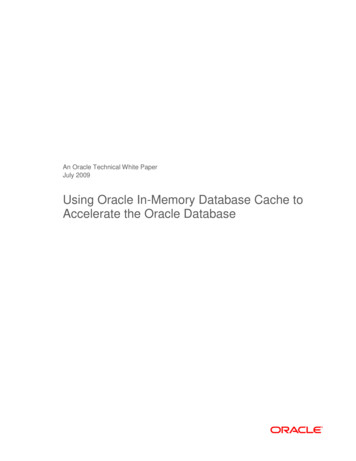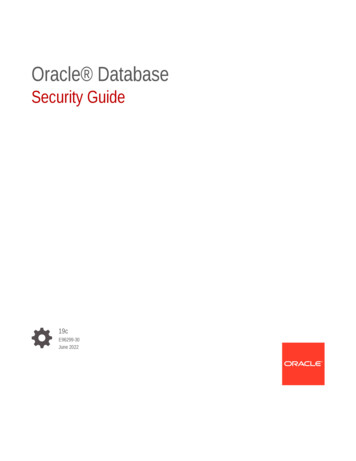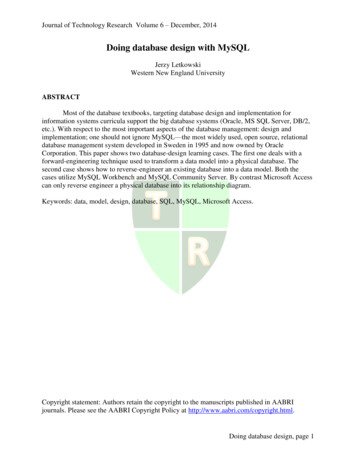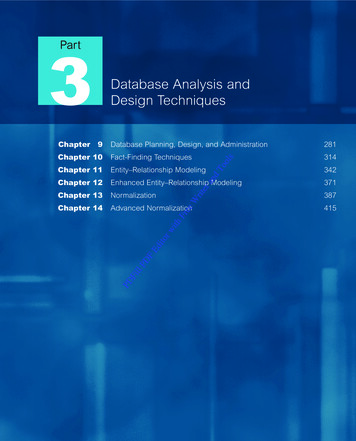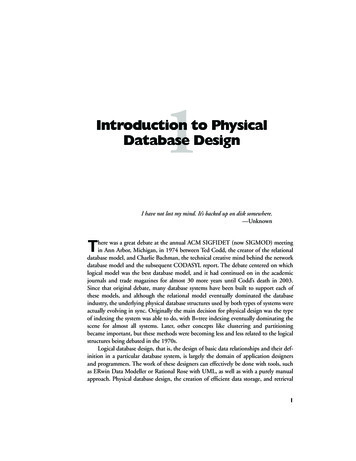
Transcription
1Introduction to PhysicalDatabase DesignI have not lost my mind. It’s backed up on disk somewhere.—UnknownThere was a great debate at the annual ACM SIGFIDET (now SIGMOD) meetingin Ann Arbor, Michigan, in 1974 between Ted Codd, the creator of the relationaldatabase model, and Charlie Bachman, the technical creative mind behind the networkdatabase model and the subsequent CODASYL report. The debate centered on whichlogical model was the best database model, and it had continued on in the academicjournals and trade magazines for almost 30 more years until Codd’s death in 2003.Since that original debate, many database systems have been built to support each ofthese models, and although the relational model eventually dominated the databaseindustry, the underlying physical database structures used by both types of systems wereactually evolving in sync. Originally the main decision for physical design was the typeof indexing the system was able to do, with B tree indexing eventually dominating thescene for almost all systems. Later, other concepts like clustering and partitioningbecame important, but these methods were becoming less and less related to the logicalstructures being debated in the 1970s.Logical database design, that is, the design of basic data relationships and their definition in a particular database system, is largely the domain of application designersand programmers. The work of these designers can effectively be done with tools, suchas ERwin Data Modeller or Rational Rose with UML, as well as with a purely manualapproach. Physical database design, the creation of efficient data storage, and retrieval1
2CHAPTER 1Introduction to Physical Database Designmechanisms on the computing platform you are using are typically the domain of thedatabase administrator (DBA), who has a variety of vendor-supplied tools availabletoday to help design the most efficient databases. This book is devoted to the physicaldesign methodologies and tools most popular for relational databases today. We useexamples from the most common systems—Oracle, DB2 (IBM), and SQL Server(Microsoft)—to illustrate the basic concepts.1.1 Motivation—The Growth of Data and IncreasingRelevance of Physical Database DesignDoes physical database design really matter? Absolutely. Some computing professionalscurrently run their own consulting businesses doing little else than helping customersimprove their table indexing design. Impressive as this is, what is equally astounding areclaims about improving the performance of problem queries by as much as 50 times.Physical database design is really motivated by data volume. After all, a database with afew rows of data really has no issues with physical database design, and the performanceof applications that access a tiny database cannot be deeply affected by the physicaldesign of the underlying system. In practical terms, index selection really does not matter much for a database with 20 rows of data. However, as data volumes rise, the physical structures that underlie its access patterns become increasingly critical.A number of factors are spurring the dramatic growth of data in all three of its captured forms: structured (relational tuples), semistructured (e.g., XML), and unstructured data (e.g., audio/video). Much of the growth can be attributed to the rapid expansion and ubiquitous use of networked computers and terminals in every home, business,and store in the industrialized world. The data volumes are now taking a further leapforward with the rapid adoption of personal communication devices like cell phonesand PDAs, which are also networked and used to share data. Databases measured in thetens of terabytes have now become commonplace in enterprise systems. Following themapping of the human genome’s three billion chemical base pairs, pharmaceutical companies are now exploring genetic engineering research based on the networks of proteinsthat overlay the human genomes, resulting in data analysis on databases severalpetabytes in size (a petabyte is one thousand terabytes, or one million gigabytes). Table1.1 shows data from a 1999 survey performed by the University of California at Berkeley. You can see in this study that the data stored on magnetic disk is growing at a rate of100% per year for departmental and enterprise servers. In fact nobody is sure exactlywhere the growth patterns will end, or if they ever will.There’s something else special that has happened that’s driving up the data volumes.It happened so quietly that seemingly nobody bothered to mention it, but the change isquantitative and profound. Around the year 2000 the price of storage dropped to apoint where it became cheaper to store data on computer disks than on paper (Figure
1.1 Motivation—The Growth of Data and Increasing Relevance of Physical Database DesignTable 1.1Worldwide Production of Original Content, Stored Digitally, in Terabytes** Source: University of California at Berkeley study, 1999.1.1). In fact this probably was a great turning point in the history of the development ofwestern civilization. For over 2,000 years civilization has stored data in written text—onparchment, papyrus, or paper. Suddenly and quietly that paradigm has begun to sunset.Now the digitization of text is not only of interest for sharing and analysis, but it is alsomore economical.The dramatic growth patterns change the amount of data that relational databasesystems must access and manipulate, but they do not change the speed at which operations must complete. In fact, to a large degree, the execution goals for data processingsystems are defined more by human qualities than by computers: the time a person iswilling to wait for a transaction to complete while standing at an automated bankingmachine or the number of available off-peak hours between closing time of a business inthe evening and the resumption of business in the morning. These are constraints thatare defined largely by what humans expect and they are quite independent of the datavolumes being operated on. While data volumes and analytic complexity are growing3
4CHAPTER 1Figure 1.1Introduction to Physical Database DesignStorage price. (Source: IBM Research.)rapidly, our expectations as humans are changing at a much slower rate. Some relief isfound in the increasing power of modern data servers because as the data volumes grow,the computing power behind them is increasing as well. However, the phenomenon ofincreasing processing power is mitigated by the need to consolidate server technology toreduce IT expenses, so as a result, as servers grow in processing power they are oftenused for an increasing number of purposes rather than being used to perform a singlepurpose faster.Although CPU power has been improving following Moore’s Law, doublingroughly every 18 months since the mid 1970s, disk speeds have been increasing at amore modest pace (see Chapter 13 for a more in-depth discussion of Moore’s Law).Finally, data is increasingly being used to detect “information” not just process “data,”and the rise of on-line analytical processing (OLAP) and data mining and other forms
1.2 Database Life Cycleof business intelligence computing has led to a dramatic increase in the complexity ofthe processing that is required.These factors motivate the need for complex and sophisticated approaches tophysical database design. Why? By exploiting design techniques a practitioner canreduce the processing time for operations in some cases by several orders of magnitude. Improving computational efficiency by a thousand times is real, and valuable;and when you’re waiting at the bank machine to get your money, or waiting for ananalysis of business trading that will influence a multimillion dollar investment decision, it’s downright necessary.1.2 Database Life CycleThe database life cycle incorporates the basic steps involved in designing a logical database from conceptual modeling of user requirements through database managementsystem (DBMS) specific table definitions, and a physical database that is indexed, partitioned, clustered, and selectively materialized to maximize real performance. For a distributed database, physical design also involves allocating data across a computer network. Once the design is completed, the life cycle continues with database implementation and maintenance. The database life cycle is shown in Figure 1.2. Physical databasedesign (step 3 below) is defined in the context of the entire database life cycle to show itsrelationship to the other design steps.1. Requirements analysis. The database requirements are determined by interviewingboth the producers and users of data and producing a formal requirements specification. That specification includes the data required for processing, the naturaldata relationships, and the software platform for the database implementation.2. Logical database design. Logical database design develops a conceptual model ofthe database from a set of user requirements and refines that model into normalized SQL tables. The goal of logical design is to capture the reality of the user’sworld in terms of data elements and their relationships so that queries andupdates to that data can be programmed easily. The global schema, a conceptualdata model diagram that shows all the data and their relationships, is developedusing techniques such as entity-relationship (ER) modeling or the Unified Modeling Language (UML). The data model constructs must ultimately be integratedinto a single global schema and then transformed into normalized SQL tables.Normalized tables (particularly third normal form or 3NF) are tables that aredecomposed or split into smaller tables to eliminate loss of data integrity due tocertain delete commands.We note here that some database tool vendors use the term logical model torefer to the conceptual data model, and they use the term physical model to refer5
6CHAPTER 1Figure 1.2Introduction to Physical Database DesignDatabase life cycle.
1.3 Elements of Physical Design: Indexing, Partitioning, and Clusteringto the DBMS-specific implementation model (e.g., SQL tables). We also notethat many conceptual data models are obtained not from scratch, but from theprocess of reverse engineering from an existing DBMS-specific schema [Silberschatz 2006]. Our definition of the physical model is given below.3. Physical database design. The physical database design step involves the selectionof indexes, partitioning, clustering, and selective materialization of data. Physicaldatabase design (as treated in this book) begins after the SQL tables have beendefined and normalized. It focuses on the methods of storing and accessing thosetables on disk that enable the database to operate with high efficiency. The goalof physical design is to maximize the performance of the database across theentire spectrum of applications written on it. The physical resources that involvetime delays in executing database applications include the CPU, I/O (e.g.,disks), and computer networks. Performance is measured by the time delays toanswer a query or complete an update for an individual application, and also bythe throughput (in transactions per second) for the entire database system overthe full set of applications in a specified unit of time.4. Database implementation, monitoring, and modification. Once the logical andphysical design is completed, the database can be created through implementation of the formal schema using the data definition language (DDL) of aDBMS. Then the data manipulation language (DML) can be used to query andupdate the database, as well as to set up indexes and establish constraints such asreferential integrity. The language SQL contains both DDL and DML constructs; for example, the “create table” command represents DDL, and the“select” command represents DML.As the database begins operation, monitoring indicates whether performancerequirements are being met. If they are not being satisfied, modifications should bemade to improve performance. Other modifications may be necessary when requirements change or end-user expectations increase with good performance. Thus, the lifecycle continues with monitoring, redesign, and modifications.1.3 Elements of Physical Design: Indexing,Partitioning, and ClusteringThe physical design of a database starts with the schema definition of logical recordsproduced by the logical design phase. A logical record (or record) is a named collection ofdata items or attributes treated as a unit by an application program. In storage, a recordincludes the pointers and record overhead needed for identification and processing bythe database management system. A file is typically a set of similarly constructed recordsof one type, and relational tables are typically stored as files. A physical database is a col-7
8CHAPTER 1Introduction to Physical Database Designlection of interrelated records of different types, possibly including a collection of interrelated files. Query and update transactions to a database are made efficient by theimplementation of certain search methods as part of the database management system.1.3.1 IndexesAn index is a data organization set up to speed up the retrieval (query) of data fromtables. In database management systems, indexes can be specified by database application programmers using the following SQL commands:CREATE UNIQUE INDEX supplierNum ON supplier(snum);/*unique index on a key*/A unique index is a data structure (table) whose entries (records) consist of attributevalue, pointer pairs such that each pointer contains the block address of an actual database record that has the associated attribute value as an index key value. This is knownas an ordered index because the attribute (key) values in the index are ordered as ASCIIvalues. If all the key values are letters, then the ordering is strictly alphabetical. Orderedindexes are typically stored as B trees so that the search for the matching key value isfast. Once the key value and corresponding data block pointer are found, there is onemore step to access the block containing the record you want, and a quick search inmemory of that block to find the record.Sometimes data is better accessed by an attribute other than a key, an attribute thattypically has the same value appear in many records. In a unique index based on a key,the key has a unique value in every record. For a nonunique attribute, an index musthave multiple attribute, pointer pairs for the same attribute value, and each pointer hasthe block address of a record that has one of those attribute values. In the B tree index,the leaf nodes contain these attribute, pointer pairs that must be searched to find therecords that match the attribute value. The SQL command for this kind of index, alsocalled a secondary index, is:CREATE INDEX shippingDate ON shipment (shipdate);/*secondary index on non-key*/In a variation of the secondary or nonunique index, it is possible to set up a collection of attribute values that you want to use to query a table. Each entry in the indexconsists of a set of attribute values and a block pointer to the record that contains exactmatches for all those attribute values in the set. An example of an SQL command to setup this kind of index is:CREATE INDEX shipPart ON shipment (pnum, shipdate);/*secondary concatenated index*/
1.3 Elements of Physical Design: Indexing, Partitioning, and ClusteringThis kind of index is extremely efficient for queries involving both a part number(pnum) and shipping date (shipdate). For queries involving just one of these attributes,it is less efficient because of its greater size and therefore longer search time.When we want to improve the query time for a table of data, say for instance thetable we access via the nonunique index on ship dates, we could organize the database sothat equivalent ship dates are stored near each other (on disk), and ship dates that areclose to each other in value are stored near each other. This type index is called a clustered index. Otherwise the index is known as a nonclustered index. There can only be oneclustered index per table because the physical organization of the table must be fixed.When the physical database table is unordered, it can be organized for efficientaccess using a hash table index often simply known as a hash index. This type of index ismost frequently based on a key that has unique values in the data records. The attribute(key) value is passed through a function that maps it to a starting block address, knownas a bucket address. The table must be set up by inserting all the records according to thehash function, and then using the same hash function to query the records later.Another variation of indexing, a bitmap index, is commonly used for secondaryindexing with multiple attribute values, and for very large databases in data warehouses.A bitmap index consists of a collection of bit vectors, with each bit vector correspondingto a particular attribute value, and for each record in the table, the bit vector is a “1” ifthat record has the designated bit vector value, and “0” if it does not. This is particularlyuseful if an attribute is sparse, that is, it has very few possible values, like gender orcourse grade. It would not work well for attributes like last name, job title, age, and soon. Bit vectors can be stored and accessed very efficiently, especially if they are smallenough to be located in memory.The analysis and design of indexes are discussed in detail in Chapters 2 and 4.1.3.2 Materialized ViewsWhen one or more tables are queried, the result can be stored in what is called a materialized view. Normally, views in SQL are stored as definitions or templates, but materialized views are stored as tables in the database just like any other table. In data warehouses, materialized views are maintained as aggregates of data in the base tables. Thesekinds of views are very useful to speed up queries of data that have been asked before(and frequently), or queries based on aggregates of data that can build on materializedviews to answer the question instead of having to go back to the original data each time.Potentially a great deal of query time savings can be realized if the proper set of materialized views is stored. It is usually impossible to store all possible views because of storage space limitations, so some means must be found to focus on the best set of views tomaterialize. There is also a problem with updates—when base tables are updated, thiscascades into the materialized views, which are derived from the base tables. The problem of multiple updates makes the use of materialized views less efficient, and this must9
10CHAPTER 1Introduction to Physical Database Designbe taken into account in their design and usage. This is discussed in more detail inChapter 5.1.3.3 Partitioning and Multidimensional ClusteringPartitioning in physical database design is a method for reducing the workload on anyone hardware component, like an individual disk, by partitioning (dividing) the dataover several disks. This has the effect of balancing the workload across the system andpreventing bottlenecks. In range partitioning, the data attribute values are sorted andranges of values are selected so that each range has roughly the same number ofrecords. Records in a given range are allocated to a specific disk so it can be processedindependently of other ranges. The details of partitioning across disks are discussed inChapter 7.Multidimensional clustering (MDC) is a technique by which data can be clusteredby dimensions, such as location, timeframe, or product type. In particular, MDCallows data to be clustered by many dimensions at the same time, such as ice skatessold in Wisconsin during the month of December. The clusters are meant to takeadvantage of known and anticipated workloads on this data. MDC is developed indetail in Chapter 8.1.3.4 Other Methods for Physical Database DesignThere are many other ways to make data access more efficient in a database. Forinstance, data compression is a technique that allows more data to fit into a fixed amountof space (on disk) and therefore accessed faster if data needs to be scanned a lot. Theoverhead for compression is in the algorithm to transform the original data into thecompressed form for storage, and then to transform the compressed form back to theoriginal for display purposes.Data striping, or just striping, is a technique for distributing data that needs to beaccessed together across multiple disks to achieve a greater degree of parallelism andload balancing, both of which makes system throughput increase and generally lowersquery times. This is particularly suited to disk array architectures like RAID (redundantarrays of independent disks) where data can be accessed in parallel across multiple disksin an organized way.Another way to improve database reliability includes data redundancy techniqueslike mirroring, in which data is duplicated on multiple disks. The downside of redundancy is having to update multiple copies of data each time a change is required in thedatabase, as well as the extra storage space required. Storage space is getting cheaperevery day, but time is not. On the other hand, data that is never or infrequently updatedmay lend itself nicely to be stored redundantly.
1.4 Why Physical Design Is HardAs part of the physical design, the global schema can sometimes be refined in limitedways to reflect processing (query and transaction) requirements if there are obvious largegains to be made in efficiency. This is called denormalization. It consists of selecting dominant processes on the basis of high frequency, high volume, or explicit priority; definingsimple extensions to tables that will improve query performance; evaluating total cost forquery, update, and storage; and considering the side effects, such as possible loss of integrity. Details are given in Chapter 15.1.4 Why Physical Design Is HardPhysical database design involves dozens and often hundreds of variables, which are difficult to keep track of, especially when their effects are very often interrelated to the various design solutions proposed. The individual computations of performance based on agiven index mechanism or partition algorithm may take several hours by hand, and performance analysis is often based on the comparison of many different configurationsand load conditions, thus requiring thousands of computations. This has given rise toautomated tools such as IBM’s DB2 Design Advisor, Oracle’s SQL Access Advisor, Oracle’s SQL Tuning Advisor, and Microsoft’s Database Tuning Advisor (DTA), formerlyknown as the Index Tuning Wizard. These tools make database tuning and performanceanalysis manageable, allowing the analyst to focus on solutions and tradeoffs while taking care of the myriad of computations that are needed. We will look at both manualanalysis and automatic design tools for physical database design in this book.TIPS AND INSIGHTS FOR DATABASE PROFESSIONALS Tip 1. The truth is out there, but you may not need it. Every database has a theoreticaly perfect, or "optimal", physical design. In reality almost nobody ever finds itbecause the search complexity is too high and the validation process too cumbersome.Database design is really hard problem. However, the complexity is mitigated by thepractical fact that at the end of the day what matters most is not whether the databaseperformance is as good as it can theoretically be, but whether the applications that usethe database perform "good enough" so that their users are satisfied. Good enough is avague and subjective definition of course. In most cases, while the perfect databasedesign is usually elusive, one that performs more than 85% of optimal can be achievedby mere mortals.11
12CHAPTER 1Introduction to Physical Database Design Tip 2. Be prepared to tinker. The possibilities are endless, and you will never be able toexplore them all. But with some wisdom and insight you and some playing around withpossibilities you can go far. Trial and error is part of the process. Tip 3. Use the tools at your disposal. Throughout this book we will describe varioustechniques and methods for physcal database design. Many database design perform anorder of magnitude worse than they could simply because the designer didn’t bother touse the techniques available. Database designs does not begin and end with simple single column index selection. By exploiting features like memory tuning, materializedviews, range partitioning, multidimensional clustering, clustering indexes, or sharednothing partitioning you can dramatically improve on a basic database design, especially for complex query processing.1.5 Literature SummaryDatabase system and design textbooks and practitioners’ guides that give seriousattention to the principles of physical database design include Burleson [2005],Elmasri and Navathe [2003], Garcie-Molina, Ullman, and Widom [2000, 2001],Ramakrishnan and Gehrke [2004], Shasha and Bonnet [2003], and Silberschatz,Korth, and Sudarshan [2006].Knowledge of logical data modeling and physical database design techniques isimportant for database practitioners and application developers. The database life cycleshows what steps are needed in a methodical approach to database design from logicaldesign, which is independent of the system environment, to physical design, which isbased on maximizing the performance of the database under various workloads.Agarwal, S., Chaudhuri, S., Kollar, L., Maranthe, A., Narasayya, V., and Syamala, M.Database Tuning Advisor for Microsoft SQL Server 2005. 30th Very Large DatabaseConference (VLDB), Toronto, Canada, 2004.Burleson, D. Physical Database Design Using Oracle. Boca Raton, FL: Auerbach Publishers, 2005.Elmasri, R., and Navathe, S. B. Fundamentals of Database Systems. Boston: AddisonWesley, 4th ed. Redwood City, CA, 2004.Garcia-Molina, H., Ullman, J., and Widom, J. Database System Implementation. Englewood Cliffs, NJ: Prentice-Hall, 2000.Garcia-Molina, H., Ullman, J., and Widom, J. Database Systems: The Complete Book.Englewood Cliffs, NJ: Prentice-Hall, 2001.
1.5 Literature SummaryOracle—SQL Tuning Advisor, cSQLTuning10g.php.Ramakrishnan, R., and Gehrke, J. Database Management Systems, 3rd ed. New York:McGraw-Hill, 2004.Shasha, D., and Bonnet, P. Database Tuning. San Francisco: Morgan Kaufmann, 2003.Silberschatz, A., Korth, H. F., and Sudarshan, S. Database System Concepts, 5th ed. NewYork: McGraw-Hill, 2006.Zilio, D.C., Rao, J., Lightstone, S., Lohman, G.M., Storm, A., Garcia-Arellano, C., andFadden, S. DB2 Design Advisor: Integrated Automatic Physical Database Design.VLDB 2004, Toronto, Canada, 1087-1097.13
data relationships, and the software platform for the database implementation. 2. Logical database design. Logical database design develops a conceptual model of the database from a set of user requirements and refines that model into normal-ized SQL tables. The goal of logical design is to capture the reality of the user's



